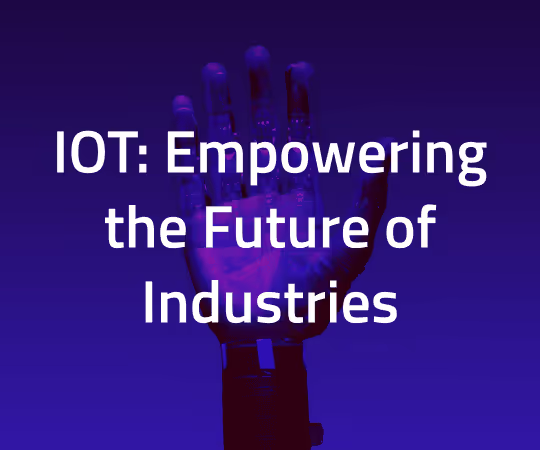IOT: Empowering the Future of Industries

The goal of the IoT is that “things” can communicate and collaborate without the need for direct human intervention. To achieve this, the devices are equipped with sensors, actuators, and internet connectivity, allowing them to collect data, exchange information, perform actions, and support decision-making based on that information.
The interconnection of IoT devices allows the creation of intelligent and automated systems that can have applications in various environments, such as the smart home, health, agriculture, transportation, and industry.
Features and advantages
The Internet of Things has several advantages and benefits, which can be:
● Automation and efficiency: Automate tasks and processes, thus achieving greater efficiency and saving time. Example: A smart thermostat can automatically adjust the temperature based on the presence or preferences of the user, saving energy.
● Data collection and analysis: It allows collecting a large amount of data in real-time, which can be analyzed to obtain valuable information and thus make more informed decisions. For example, water quality sensors can provide detailed data on the contamination of a river, allowing measures to be taken for water treatment.
● Comfort and quality of life: Provides solutions that significantly improve comfort and quality of life, such as smart home devices, which allow you to control lights, access, temperature, and even prepare food remotely or with commands in voice.
● Optimization and decision-making support: Through the data collected by IoT devices in real-time, information can be obtained on the status and performance of equipment, devices, and industrial systems, thus facilitating management and preventive maintenance and decision-making based on relevant and updated information.
Of course, the IoT also has challenges, such as security and privacy, since the connectivity of devices can expose them to cybersecurity risks and unauthorized access to personal and private data. Therefore, it is essential to take proper security measures when deploying IoT devices.
How can it be helpful in the industry?
Based on the above, the potential advantages for the industrial field are varied. The Industrial Internet of Things extends the IoT concept, specifically applied to industrial environments.
The main difference between IoT and IIoT lies in the scope of the application. While IoT focuses on the interconnection of devices and everyday objects (home appliances, wearables, vehicles, etc.), IIoT focuses on connecting industrial systems and equipment, which is often critical.
Its applications are more than varied: Factory machinery, sensors in a power plant, devices in a supply chain, etc.
Another critical difference is the degree of security and privacy required in IIoT, since in industrial environments, the information is usually more urgent, so it requires a higher level of security measures.
By implementing IoT-based solutions in the industry, several benefits can be obtained:
● Monitoring and control: By collecting real-time data from industrial equipment and processes, IIoT provides greater visibility and control over operations, thus facilitating early failure detection, efficiency optimization, informed decision-making, and even prevention or prediction of events through data analysis.
● Predictive maintenance: By collecting and analyzing data in real-time, patterns and trends can be identified that help predict problems, failures, or events in equipment and the process, thus allowing maintenance to be scheduled proactively and optimizing downtime costs and repair.
● Supply Chain: By tracking and monitoring products and materials throughout the supply chain, logistics efficiency can be improved and waste reduced, thus achieving better inventory and process management.
● Energy efficiency: With the data collected on the energy consumption of industrial equipment, areas for improvement can be identified, and the use of resources optimized with equipment automation results in significant energy savings and, therefore, costs.
● Automation and interoperability: Thanks to the integration and communication between different systems and devices in industrial environments, greater process automation can be achieved and the creation of interconnected systems that work efficiently and in a coordinated manner.
Therefore, IoT allows connectivity and data collection and analysis in industrial environments to improve operational efficiency, reduce costs and make more informed decisions.
The technology behind IoT
Implementing IoT and IIoT involves a combination of diverse technologies, including hardware and software, that collectively enable connectivity, data collection, and information analysis.
Some of these technologies are:
● Sensors and smart devices: These are the fundamental components in IoT since they are the ones that make it possible to capture data from the physical environment and send it to the cloud through the Internet. These sensors are integrated with smart devices and allow obtaining data on pressure, temperature, humidity, level, movement, etc. Thanks to their connection to the network, they can communicate with other devices and systems.
● Connectivity: It is essential for the IoT. Various technologies are used to establish connections between devices and systems. Wireless network technologies such as Wi-Fi, Bluetooth, cellular networks, LoRaWAN, and Sigfox, among others, are used. In addition, data transmission protocols such as MQTT (Message Queuing Telemetry Transport) or CoAP (Constrained Application Protocol) are used to facilitate data transmission. MQTT, the most widespread and widely used, provides APIs for several popular programming languages, such as Python, Java, Javascript, C, etc., making it easy to implement IoT on various devices and development environments.
● Cloud computing: Another essential component in IoT. Provides a scalable and secure platform for data storage and processing so that the data sent by IoT devices is stored, analyzed, and shared with other systems and applications. Various cloud services are available specifically for IoT applications, such as AWS IoT, Microsoft Azure IoT, and Google Cloud IoT, all offering tools and functionality specific to IoT applications.
● Big data and data analytics: The vast amount of data generated by IoT devices requires advanced analytics techniques to extract valuable insights. Big data and data analytics techniques allow for processing and analyzing large volumes of data in real-time. This includes techniques such as complex event processing (CEP), machine learning, and artificial intelligence (AI), which help identify patterns, make data-driven decisions, and predict future behavior.
● Security and privacy: Security in IoT is essential since it involves the transfer and storage of sensitive data, so it is critical to take rigorous security and privacy measures. To achieve this, several technologies are used, such as cryptography, authentication, access control, and firewalls, to minimize the possibilities of unwanted access and thus protect data and systems against threats.
IoT is a significant advancement for our daily lives, and even more so for improving industrial processes. Therefore, it is an area growing more each day as more companies and industries embrace IIoT to optimize their operations.
Other Blog Posts

Work-Life Balance: The Solution to High Turnover of Software Engineers?

Why hire Latin American Developers for your business?






